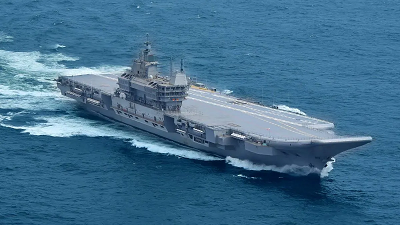Context-
Recent media reports indicate that the Indian Navy’s long-standing demand for a third aircraft carrier is finally progressing, with Cochin Shipyard Limited (CSL) set to begin constructing an additional Vikrant-class 40,000-odd tonne platform. Building the Indigenous Aircraft Carrier-2 (IAC-2), albeit with upgrades, modifications, and greater local content compared to IAC-1 Vikrant, is intended to prevent CSL’s carrier-building expertise from lapsing into disuse. The Navy remains palpably conscious of avoiding a repeat of the 'lost decade' between 1995 and 2005 when Mazagaon Dock Shipbuilder's (MDL) submarine building expertise was allowed to dissipate.
Preventing the Loss of Expertise
This costly fumble led to MDL’s submarine construction facilities disintegrating, following the unresolved corruption scandal involving the Indian Navy’s purchase of four German HDW Type 209/1500 diesel-electric submarines (SSKs). These facilities were resurrected in 2005 at a high cost to license-construct six French Scorpene SSKs, five of which have already been commissioned into Indian Navy service, with the sixth due for induction by the year-end. Hence, the Navy’s keenness on averting a similar lapse with CSL by insisting on a larger carrier of around 65,000 tonnes and settling instead for the ‘interim’ IAC-2.
Meeting Future Needs and Addressing Concerns
The IAC-2 would supplement INS Vikramaditya, the 46,000-tonne refurbished Russian Kiev-class vessel, and the 40,262-tonne short-take-off barrier-arrested recovery (STOBAR) Vikrant, fulfilling the Navy’s enduring requirement for one carrier each for its two seaboards, and another in reserve. The debate over IAC-2 has been plagued by numerous reservations, including its astronomical cost of around $5-6 billion and its operational efficacy in an environment of burgeoning anti-access/area denial (A2/AD) capability honed by China and Pakistan.
Strategic Challenges and Operational Debates
The A2/AD strategy, essentially a multi-layered defensive approach to deter enemy carrier operations, has been bolstered by advances in cruise missile technology. This has made it easier and cheaper for countries like China and Pakistan to conduct A2/AD operations, posing a significant threat even to the U.S. Navy, which remains wary of challenging it.
Within the Indian Navy, opinion is split between pursuing a ‘sea denial’ strategy, largely by deploying submarines, or alternatively seeking a ‘sea control’ approach via costly and relatively more vulnerable carrier battle groups comprising multiple surface and underwater escorts. Some also questioned the monetary logic of building a new carrier at the cost of inducting additional ‘killer-hunter’ SSKs. The Indian Navy’s submarine fleet has dwindled to 16, with 11 from Russia and Germany either beyond or nearing retirement. This number is eight boats fewer than the 24 projected to be operated by 2030 according to the Navy's Maritime Capability Perspective Plan (MCPP).
Financial Constraints and Competing Priorities
Financial constraints have forced the Indian Navy to revise its goal of operating 200 assorted warships by 2027, as per the MCPP. These fiscal shortages have also reduced the Navy’s demand for 12 mine counter-measures to eight and an additional 10 Boeing P-8I Neptune long-range maritime multi-mission aircraft to just six.
The Indian Air Force (IAF), along with the Indian Army, is constantly competing for a larger share of depreciating annual defense budgets. The IAF is grappling to make good its fighter, helicopter, and transport aircraft shortages, alongside other essential equipment. IAF veterans argue that under prevailing penurious conditions, an aircraft carrier would not only be a costly indulgence but also entail fielding a platform vulnerable to formidable A2/AD threats.
Alternative Strategies and Capabilities
Other IAF officers believe that SEPECAT Jaguar IM/IS and multi-role Russian Sukhoi Su-30MKI fighters, fitted with enhanced maritime strike capability and extended strike ranges, could project power more economically and securely than a carrier. The IAF’s maritime Jaguar IM fleet, for instance, is armed with AGM-84L Block II Harpoon missiles and is being equipped with Israel Aerospace Industries-Elta EL/M-2052/2060 multi-mode active electronically scanned array radar for sea-borne operations.
In early 2020, the IAF commissioned its first Su-30MKI squadron, armed with the BrahMos-A (Air) supersonic cruise missile at Thanjavur on India’s southeast coast, to monitor its seacoast and the wider Indian Ocean Region. Military planners said Su-30MKI would enhance the IAF’s capability to engage potential maritime targets with pinpoint accuracy.
Upgrading Andaman and Nicobar Capabilities
Other navalists favor upgrading the military capabilities of the Andaman and Nicobar archipelago, by creating an A2/AD maritime ‘exclusive zone’ around it to deter, amongst others, the hegemonic Chinese navy. While the archipelago is immovable, it is likely to be cheaper than an aircraft carrier and, besides being unsinkable, it offers strategic advantages.
Conclusion
Building the IAC-2, with upgrades, modifications, and greater local content compared to IAC-1 Vikrant, is essential not only to maintain CSL's carrier-building expertise but also to fulfill the Indian Navy's strategic requirements. Despite financial constraints and competing priorities, the development of a third aircraft carrier remains crucial for India's maritime security and strategic positioning in the Indian Ocean Region. The debate over its necessity highlights the complex interplay between cost, capability, and strategic imperatives that India must navigate to enhance its naval prowess and ensure national security.
|
Probable Questions for UPSC Mains Exam-
|
Source- The Hindu







